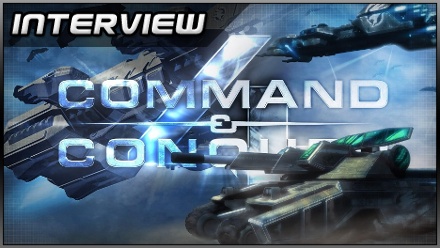- Joined
- Oct 22, 2008
- Messages
- 27,352
- Reaction score
- 136
Command & Conquer 4: Tiberian Twilight Interview
Epic, six page marathon chat with EA producer on appeasing the hardcore, obligatory logins, dumping Gamespy, the joy of Halo Wars and where the RTS will go next.
Depending on who you read, real-time strategy is dead, dying or cuddled up in a leather armchair somewhere polishing its war medals and writing angry letters to the local gazette. The genre needs a shot in the arm, and what better franchise to wield the syringe than Command & Conquer, one of the oldest and most successful of top-down tank molesters. At a recent EA showcase, we caught up with Raj Joshi, producer on Command & Conquer 4: Tiberian Twilight, for his thoughts on base-building, the competition and whether you really can squeeze the full range of options into an Xbox 360 controller.
VideoGamesDaily: Hello Raj, thanks for chatting with us. Do you think this kind of preview event does justice to a game, particularly an RTS title like this one? You don’t really get to experience the feature set in full…
Raj Joshi: I think it works pretty good, getting everybody together for the first time for a hands on on multiplayer, getting into a match and seeing how it comes alive dynamically with many people. We’ve been doing hands-on one-on-one through the single player campaign, and I think that although single player’s very important for Command and Conquer because a lot of people try to do that, I think our game really shines when you have five team-mates, you get to see the three different classes in action and work together with people.
So we’ve had some people play through three to four rounds, I think that’s where people get the real taste of it. It is tough because you need long enough to tech up and really get a feel for things, get well-versed… But I think it’s a good taste. Definitely better than half an hour sitting down with the single player campaign, trying to get through a mission, and trying to base an opinion on that. I think this is a little better than our single player stuff we’ve been doing lately.
VGD: Obviously the fanbase for the core series is huge and passionate, but do you think that the fourth game is one newcomers will get into?
Joshi: I think more so than before, having the mobile crawler, the class choice which hopefully will appeal to first-person shooter multiplayer players, where it’s more focussed. Rather than having all 88 units accessible at once and trying to figure out your path, you pick a class and that kind of determines your play style. Having that mobile base and not having to do Tiberium harvesting will hopefully help people jump in, and not having as many units to control at once. Plus the play style of multiplayer is more like first person shooter mode, where it’s kind of this domination style capturing of control points.
We’re hoping all these things kind of added together will make it easier to get into. It’s not a casual game by any stretch of the information, but I think more casual than, like, Red Alert 3, where the build order was very specific, all the units were very specifically good at one little thing. So that one was very oriented to the micromanaging player.
VGD: The C&C fan community is particularly close to the development team. Does the new game owe much to this relationship?
Joshi: Definitely. One thing, as far as the story goes, is that we’ve really researched everything the community has written over the past 15 years and integrated a lot of their lore into the way we’re wrapping up the Tiberium saga. So a lot of the key story points came from the community as well, and then were bedded back out with the community again.
We had a big community event at Cologne, at Gamescom, where we had 100 of the community members from around the world come and play through the beta, and really talk through a lot of the features of the game, how the multiplayer played for them, took a lot of their feedback and incorporated it into the beta that we have going on right now. They were really upset that there was no Tiberium harvesting – we pulled Tiberium out because we had a mobile base, we didn’t want to just leave the harvester off in the middle of nowhere, in a Tiberium field.
So we got rid of that, also making it more accessible for the newer player. They clamoured for some kind of Tiberium harvesting, so we came up with this crystal mechanic where you capture these Tiberium crystals, take them back to your spawn zone, and that gives you your upgrade points to then tech up and get new upgrades.
We got some community members over to the studio for a week, and just did a lot of concentrated focus tests, really worked on the balance of the game, and some of the core mechanics. So taking their input from map layout, a lot of feedback on unit balance, user interface, really trying to pour that back in. Because you can think that you have a great game, but it’s really when it gets into the hands of its core players that you start to see where you want to tear it up a bit.
VGD: In terms of the Tiberium Saga, where are you looking to take the universe from here?
Joshi: One of the things that I really notice in modern media is that you have some really great stories and they have to be concluded. You can’t necessarily drag them a series on too long. So we’re trying to wrap up all the loose ends, but it does leave a lot of room for exploring Command and Conquer. The core story between GDI and Kane, that story did seem like it needed to be wrapped up and given a solid conclusion. As far as the Command and Conquer universe goes, it’ll keep living on.
VGD: So perhaps the fifth game will open up a new narrative?
Joshi: I think a lot of that stuff is yet to be figured out really. The main focus is on getting this game solid, making sure that it’s appropriately representative of Command and Conquer, and to give people the chance to continue to explore online.
VGD: What’s behind the decision to provide your own servers this time, rather than using GameSpy?
Joshi: We really wanted to be independent on match-making, and to be completely in control of how many servers are set up specifically dedicated to our game. The infrastructure and the way we set it up and the way that we actually host our matches, the way we do it now is far more limited, the possibility of desynching or disconnecting is far more limited. And also we’re able to send the data and keep everything up on the server.
So we’re no longer dependent on any one of the people playing the game. The data packets that are getting passed back and forth are small, but if somebody has a slower connection it’s not dragging the rest of the game down. We just kind of wanted to break away and be more impatient, be more in control of it, and also ensure our future support for the game.
VGD: Do you think more developers will own their own servers in future?
Joshi: Yeah – I mean, Gamespy provides a good service that we’ve obviously used for years. The main thing is that when you are dependent on anybody outside of your core team, there’s more potential elements of failure, there’s more opportunities for miscommunication and difficulty.
Bringing it internally allows us to control it all the way and especially when we’re trying to tailor our performance that’s just one less factor we have to deal with. The main thing is that our backend and all of our networking is all internal to us right now, and it’s kind of a delicate dance – being able to control how the servers are managing the games makes it that much easier for us.
VGD: What’s the rationale behind obliging players to login to the server in order to load up the game?
Joshi: What that allows us to do is to have a persistent profile, so you play at your computer, you go to your friend’s house, you load up the game, you sign into your profile, and all your data’s right there. We’re storing everything on the server so that nothing’s stuck on any one terminal. This is especially good for gaming cafes. If you just want to go and play – you want to invest 20 or 30 minutes playing, then sign out, and go on your way, maybe hop into a friend’s place or internet cafe, you can just sign straight back into your profile. Everything that you’ve done – your single player, multiplayer, against the AI, that’s all stored online.
VGD: Do you think the advantages of mandatory logins will outweigh the disadvantages?
Joshi: We’re hoping so, because people don’t always react well to that, they want to do LAN play or play offline. And I understand that, but the benefit of having all your stuff up on the server – we’re hoping that appeals to people more than the perceived drawbacks.
VGD: Were you involved with the team which brought Command and Conquer 3 to Xbox 360?
Joshi: Yes, it was me and another subset of the team.
VGD: What did you learn from the experience of putting an RTS on a console?
Joshi: It’s a pretty broad question, but we started with Battle for MiddleEarth 2, and that was more of a direct “how do you get a PC RTS onto a console” question, how do you get all that functionality in there. We basically just tried to emulate as much as possible how the PC version worked, but in doing that it turned out pretty well and the reception was good, and we got a lot of people turned onto RTS that would never have played it otherwise, because a lot of people are solely console players.
But when we came to C&C3 we kind of wanted to get away from the linear build order where you had to use the D-pad to scroll through things, so we started developing the radial but it wasn’t quite there for shipping, so we stayed with that. We were able to refine some of the controls, little things like clicking the stick to jump back to your MCV… Little shortcuts on the D-pad, grouping and stuff. So we started learning how to utilise all the different controls on the controller, which is actually pretty robust, there’s a lot of unique things you can do with it.
And then finally when we went to Kane’s Wrath it finally gave you the radial interface, and that was really where RTS had to go on a console. Because we were actually able to – towards the tail end of C&C3 we had the radial outlined but we weren’t ready to implement, and you can actually build and control your forces faster on the PC, because you got quick through muscle memory. So that was some of the stuff that we learned how to refine.
RTS is all about micro-management, about being able to click all over the place and jump anywhere on the map – we were trying to figure out how to make that easier, porting over to the console, that’s what we kind of learned. And along the way learn areas that you could refine. And not take away user control, but limit it – maybe there are some areas where it’s not really even that important anymore, and see what people would miss and what not.
VGD: And that’s presumably something you haven’t needed to experiment with this time.
Joshi: Well this is PC exclusive for now, with no real plans for console. But I thought it was exciting. You even saw Halo Wars come out…
VGD: Yes, and that was built from the ground up for consoles. Did it bring anything fresh to the concept of console RTS for you?
Joshi: It was interesting. One thing that we actually liked was that they did borrow some stuff from us, originally, even though they were in development for a long time. So it was nice to see that they had adopted some of the stuff that we had proven out. And then one of the things that we in looking at Halo Wars really liked was that you had a constant view of who was selected in your army, and were able to ‘drill into’ them.
That was something we thought was really interesting – OK, I have a selection set, it may not be control-grouped, you immediately are able to see everybody who’s on the map who’s selected and what’s going on with them. So that was something we really liked. We did find that Halo Wars was somewhat simplistic, kind of an easy play, but that may have been part of their overall strategy of getting people hooked into it, people who were originally Halo fans.
VGD: Given your experiences with Kane’s Wrath on console, is there anything you’d borrow back from Halo Wars?
Joshi: I think some of their mission design was interesting – it did lend to not having to jump too far around the map. We haven’t had the opportunity to develop a console-specific RTS, and I think that would definitely change up our mission design. Other than that, their stuff was big. That was one thing we liked. Their stuff was big and simple. And that’s something where being able to design specifically for console you limit your design a bit to make everything a little more digestible. So I appreciated that. They also had a beautiful engine, so that’s something that we’d like to take advantage of.
VGD: Shame about the IP, which no-one’s ever heard of, obviously…!
Joshi: [laughs] Yeah, it’s too bad for them. They finally get their chance…
VGD: …And they blow it on Halo. Just to finish off then: where do you see RTS as a genre going next?
Joshi: It’s interesting. I think it was World in Conflict that allowed us to put the camera anywhere, fill the environment with all kinds of particle effects and stuff like that. StarCraft is obviously going to come forward – they have such a cult following at this point, in Asia especially. It feels like – because the console market is so strong and the PC market is still definitely present, but I don’t know if it’s getting stronger… RTS has a really strong community base. C&C has a strong community, but RTS has its specific followers.
I don’t know how many new adopters there are to the genre. So it’s curious because, especially in our economic times, it’s tougher to fund a project which isn’t going to get the same economic return. A first-person shooter on console, you know that thing’s going to get a return. Everybody’s going to jump to it. And that’s why I’d like to see RTS being more adopted to console, being pushed in that direction, and RTS as a genre changing, splintering off into a console-specific type option, where it’s maybe a little more of a mix – some tactical play, and also being able to get into your units.
But I think RTS can do well if you go into an online-only format, look for downloadable content that kind of spices things up. We have player progression going on and I’d like to see player progression blown out a little bit more – you get that RPG element where the longer you invest, the more advanced your armies become and the more goodies you get – continuing to spiral that out with more offerings that people can grab through micro-transactions or earning.
So I kind of see it living in that way. I think traditional box products are getting more difficult, with the way they have to be pushed to market and supported. I think you’ll see genres like RTS probably go more the online route.
VGD: Do you think there’s a presentational issue? Even the most accessible of real-time strategy games can seem very fiddly, very intent on fine detail, perhaps a little clinical. Is there a way to glam that up for the consumer who sets more store by visual overkill?
Joshi: We definitely did a lot of refining – improving our renderer, improving a lot of little bits of the game engine, the effect system is all brand new. But you have to draw so many units and effects on the screen at any one time, versus one character not even being rendered on the screen, just drawing the environment, that you’re limited.
VGD: Sorry, I meant ‘presentation’ in terms of cinematic technique. Maybe you could put in some cutaway close-ups when buildings explode, or something in that vein.
Joshi: There are times when you want to break the camera away, and there are definitely usability concerns that we worry about when you actually wrestle the camera back from the user. But yes, I would like some of those moments, because the cool thing about videogames is that you as the player are the main character. You are not passive, just watching.
Now in real-time strategy you are obviously making every single decision, but your level of immersion is definitely different from that of a first-person shooter. I would like to see more of that, I think there’s definitely room for that in single player presentation. I personally would like to see RTS have fewer units, and be able to get right up into the action, and blend in a little bit of first-person shooter and RTS style.
So it’s different – and the draw of new users to real-time strategy, I think that’s definitely a question a lot of people are wrestling with right now. We want to open up the genre to people who are not used to playing it, but it’s definitely very different, you’re obviously a little more separated from the gameplay.
VGD: And obviously you don’t want to water it down for the core users.
Joshi: Yes, because we’ve made a lot of decisions to make it more accessible, but it’s not the Sims. It’s more accessible, but there’s definitely the hardcore contingent who are like “hey, we want to micromanage, we want to harvest Tiberium, we want to build a base and just hang out at the base”. Whereas we want to get people into the game, get the game moving a little bit faster. It’s a tough one.
I really think other genres are kind of splitting – though they aren’t really calling it out so much – and I think RTS should split too. You should have more of a casual vein, and more of a hardcore vein. There’s no way to satisfy both groups, and I think there’s interest from both sides.
VGD: Raj, thanks for your time.
Tiberian Twilight is out for PC on 16th March in North America and 19th March in Europe.
Quelle: http://videogamesdaily.com/interviews/201002/command-conquer-4-tiberian-twilight-interview/
Epic, six page marathon chat with EA producer on appeasing the hardcore, obligatory logins, dumping Gamespy, the joy of Halo Wars and where the RTS will go next.
Depending on who you read, real-time strategy is dead, dying or cuddled up in a leather armchair somewhere polishing its war medals and writing angry letters to the local gazette. The genre needs a shot in the arm, and what better franchise to wield the syringe than Command & Conquer, one of the oldest and most successful of top-down tank molesters. At a recent EA showcase, we caught up with Raj Joshi, producer on Command & Conquer 4: Tiberian Twilight, for his thoughts on base-building, the competition and whether you really can squeeze the full range of options into an Xbox 360 controller.
VideoGamesDaily: Hello Raj, thanks for chatting with us. Do you think this kind of preview event does justice to a game, particularly an RTS title like this one? You don’t really get to experience the feature set in full…
Raj Joshi: I think it works pretty good, getting everybody together for the first time for a hands on on multiplayer, getting into a match and seeing how it comes alive dynamically with many people. We’ve been doing hands-on one-on-one through the single player campaign, and I think that although single player’s very important for Command and Conquer because a lot of people try to do that, I think our game really shines when you have five team-mates, you get to see the three different classes in action and work together with people.
So we’ve had some people play through three to four rounds, I think that’s where people get the real taste of it. It is tough because you need long enough to tech up and really get a feel for things, get well-versed… But I think it’s a good taste. Definitely better than half an hour sitting down with the single player campaign, trying to get through a mission, and trying to base an opinion on that. I think this is a little better than our single player stuff we’ve been doing lately.
VGD: Obviously the fanbase for the core series is huge and passionate, but do you think that the fourth game is one newcomers will get into?
Joshi: I think more so than before, having the mobile crawler, the class choice which hopefully will appeal to first-person shooter multiplayer players, where it’s more focussed. Rather than having all 88 units accessible at once and trying to figure out your path, you pick a class and that kind of determines your play style. Having that mobile base and not having to do Tiberium harvesting will hopefully help people jump in, and not having as many units to control at once. Plus the play style of multiplayer is more like first person shooter mode, where it’s kind of this domination style capturing of control points.
We’re hoping all these things kind of added together will make it easier to get into. It’s not a casual game by any stretch of the information, but I think more casual than, like, Red Alert 3, where the build order was very specific, all the units were very specifically good at one little thing. So that one was very oriented to the micromanaging player.
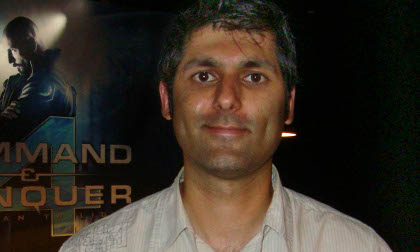
The man himself.
VGD: The C&C fan community is particularly close to the development team. Does the new game owe much to this relationship?
Joshi: Definitely. One thing, as far as the story goes, is that we’ve really researched everything the community has written over the past 15 years and integrated a lot of their lore into the way we’re wrapping up the Tiberium saga. So a lot of the key story points came from the community as well, and then were bedded back out with the community again.
We had a big community event at Cologne, at Gamescom, where we had 100 of the community members from around the world come and play through the beta, and really talk through a lot of the features of the game, how the multiplayer played for them, took a lot of their feedback and incorporated it into the beta that we have going on right now. They were really upset that there was no Tiberium harvesting – we pulled Tiberium out because we had a mobile base, we didn’t want to just leave the harvester off in the middle of nowhere, in a Tiberium field.
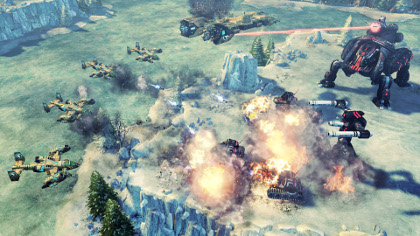
You and what army? Oh, that one.
So we got rid of that, also making it more accessible for the newer player. They clamoured for some kind of Tiberium harvesting, so we came up with this crystal mechanic where you capture these Tiberium crystals, take them back to your spawn zone, and that gives you your upgrade points to then tech up and get new upgrades.
We got some community members over to the studio for a week, and just did a lot of concentrated focus tests, really worked on the balance of the game, and some of the core mechanics. So taking their input from map layout, a lot of feedback on unit balance, user interface, really trying to pour that back in. Because you can think that you have a great game, but it’s really when it gets into the hands of its core players that you start to see where you want to tear it up a bit.
VGD: In terms of the Tiberium Saga, where are you looking to take the universe from here?
Joshi: One of the things that I really notice in modern media is that you have some really great stories and they have to be concluded. You can’t necessarily drag them a series on too long. So we’re trying to wrap up all the loose ends, but it does leave a lot of room for exploring Command and Conquer. The core story between GDI and Kane, that story did seem like it needed to be wrapped up and given a solid conclusion. As far as the Command and Conquer universe goes, it’ll keep living on.
VGD: So perhaps the fifth game will open up a new narrative?
Joshi: I think a lot of that stuff is yet to be figured out really. The main focus is on getting this game solid, making sure that it’s appropriately representative of Command and Conquer, and to give people the chance to continue to explore online.
VGD: What’s behind the decision to provide your own servers this time, rather than using GameSpy?
Joshi: We really wanted to be independent on match-making, and to be completely in control of how many servers are set up specifically dedicated to our game. The infrastructure and the way we set it up and the way that we actually host our matches, the way we do it now is far more limited, the possibility of desynching or disconnecting is far more limited. And also we’re able to send the data and keep everything up on the server.
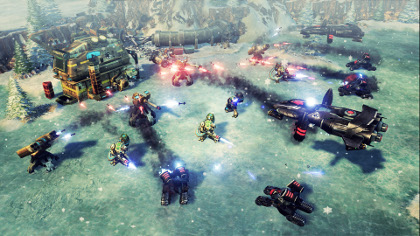
Air units: never as tough as they look.
So we’re no longer dependent on any one of the people playing the game. The data packets that are getting passed back and forth are small, but if somebody has a slower connection it’s not dragging the rest of the game down. We just kind of wanted to break away and be more impatient, be more in control of it, and also ensure our future support for the game.
VGD: Do you think more developers will own their own servers in future?
Joshi: Yeah – I mean, Gamespy provides a good service that we’ve obviously used for years. The main thing is that when you are dependent on anybody outside of your core team, there’s more potential elements of failure, there’s more opportunities for miscommunication and difficulty.
Bringing it internally allows us to control it all the way and especially when we’re trying to tailor our performance that’s just one less factor we have to deal with. The main thing is that our backend and all of our networking is all internal to us right now, and it’s kind of a delicate dance – being able to control how the servers are managing the games makes it that much easier for us.
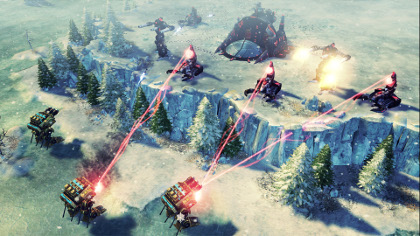
Elevation doesn't seem to play much of a role in combat.
VGD: What’s the rationale behind obliging players to login to the server in order to load up the game?
Joshi: What that allows us to do is to have a persistent profile, so you play at your computer, you go to your friend’s house, you load up the game, you sign into your profile, and all your data’s right there. We’re storing everything on the server so that nothing’s stuck on any one terminal. This is especially good for gaming cafes. If you just want to go and play – you want to invest 20 or 30 minutes playing, then sign out, and go on your way, maybe hop into a friend’s place or internet cafe, you can just sign straight back into your profile. Everything that you’ve done – your single player, multiplayer, against the AI, that’s all stored online.
VGD: Do you think the advantages of mandatory logins will outweigh the disadvantages?
Joshi: We’re hoping so, because people don’t always react well to that, they want to do LAN play or play offline. And I understand that, but the benefit of having all your stuff up on the server – we’re hoping that appeals to people more than the perceived drawbacks.
VGD: Were you involved with the team which brought Command and Conquer 3 to Xbox 360?
Joshi: Yes, it was me and another subset of the team.
VGD: What did you learn from the experience of putting an RTS on a console?
Joshi: It’s a pretty broad question, but we started with Battle for MiddleEarth 2, and that was more of a direct “how do you get a PC RTS onto a console” question, how do you get all that functionality in there. We basically just tried to emulate as much as possible how the PC version worked, but in doing that it turned out pretty well and the reception was good, and we got a lot of people turned onto RTS that would never have played it otherwise, because a lot of people are solely console players.
But when we came to C&C3 we kind of wanted to get away from the linear build order where you had to use the D-pad to scroll through things, so we started developing the radial but it wasn’t quite there for shipping, so we stayed with that. We were able to refine some of the controls, little things like clicking the stick to jump back to your MCV… Little shortcuts on the D-pad, grouping and stuff. So we started learning how to utilise all the different controls on the controller, which is actually pretty robust, there’s a lot of unique things you can do with it.
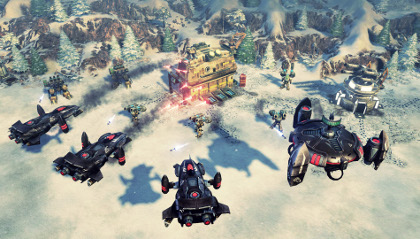
A GDI base takes a pummelling.
And then finally when we went to Kane’s Wrath it finally gave you the radial interface, and that was really where RTS had to go on a console. Because we were actually able to – towards the tail end of C&C3 we had the radial outlined but we weren’t ready to implement, and you can actually build and control your forces faster on the PC, because you got quick through muscle memory. So that was some of the stuff that we learned how to refine.
RTS is all about micro-management, about being able to click all over the place and jump anywhere on the map – we were trying to figure out how to make that easier, porting over to the console, that’s what we kind of learned. And along the way learn areas that you could refine. And not take away user control, but limit it – maybe there are some areas where it’s not really even that important anymore, and see what people would miss and what not.
VGD: And that’s presumably something you haven’t needed to experiment with this time.
Joshi: Well this is PC exclusive for now, with no real plans for console. But I thought it was exciting. You even saw Halo Wars come out…
VGD: Yes, and that was built from the ground up for consoles. Did it bring anything fresh to the concept of console RTS for you?
Joshi: It was interesting. One thing that we actually liked was that they did borrow some stuff from us, originally, even though they were in development for a long time. So it was nice to see that they had adopted some of the stuff that we had proven out. And then one of the things that we in looking at Halo Wars really liked was that you had a constant view of who was selected in your army, and were able to ‘drill into’ them.
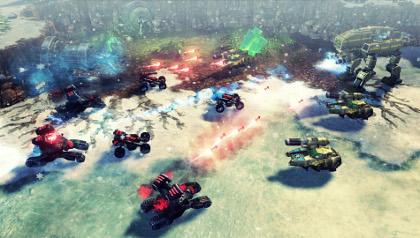
Tiberian Twilight's aesthetic is equal parts Dawn of War and Super Soaker.
That was something we thought was really interesting – OK, I have a selection set, it may not be control-grouped, you immediately are able to see everybody who’s on the map who’s selected and what’s going on with them. So that was something we really liked. We did find that Halo Wars was somewhat simplistic, kind of an easy play, but that may have been part of their overall strategy of getting people hooked into it, people who were originally Halo fans.
VGD: Given your experiences with Kane’s Wrath on console, is there anything you’d borrow back from Halo Wars?
Joshi: I think some of their mission design was interesting – it did lend to not having to jump too far around the map. We haven’t had the opportunity to develop a console-specific RTS, and I think that would definitely change up our mission design. Other than that, their stuff was big. That was one thing we liked. Their stuff was big and simple. And that’s something where being able to design specifically for console you limit your design a bit to make everything a little more digestible. So I appreciated that. They also had a beautiful engine, so that’s something that we’d like to take advantage of.
VGD: Shame about the IP, which no-one’s ever heard of, obviously…!
Joshi: [laughs] Yeah, it’s too bad for them. They finally get their chance…
VGD: …And they blow it on Halo. Just to finish off then: where do you see RTS as a genre going next?
Joshi: It’s interesting. I think it was World in Conflict that allowed us to put the camera anywhere, fill the environment with all kinds of particle effects and stuff like that. StarCraft is obviously going to come forward – they have such a cult following at this point, in Asia especially. It feels like – because the console market is so strong and the PC market is still definitely present, but I don’t know if it’s getting stronger… RTS has a really strong community base. C&C has a strong community, but RTS has its specific followers.
I don’t know how many new adopters there are to the genre. So it’s curious because, especially in our economic times, it’s tougher to fund a project which isn’t going to get the same economic return. A first-person shooter on console, you know that thing’s going to get a return. Everybody’s going to jump to it. And that’s why I’d like to see RTS being more adopted to console, being pushed in that direction, and RTS as a genre changing, splintering off into a console-specific type option, where it’s maybe a little more of a mix – some tactical play, and also being able to get into your units.
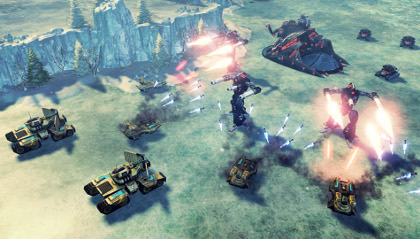
Battle mech time! Wonder if the NOD brotherhood are Evangelion fans.
But I think RTS can do well if you go into an online-only format, look for downloadable content that kind of spices things up. We have player progression going on and I’d like to see player progression blown out a little bit more – you get that RPG element where the longer you invest, the more advanced your armies become and the more goodies you get – continuing to spiral that out with more offerings that people can grab through micro-transactions or earning.
So I kind of see it living in that way. I think traditional box products are getting more difficult, with the way they have to be pushed to market and supported. I think you’ll see genres like RTS probably go more the online route.
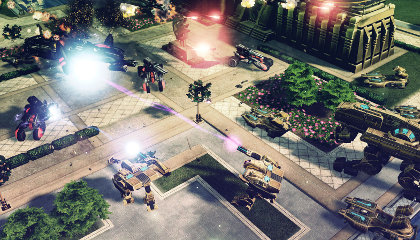
In the grim darkness of the far future, all the neat gear will have legs.
VGD: Do you think there’s a presentational issue? Even the most accessible of real-time strategy games can seem very fiddly, very intent on fine detail, perhaps a little clinical. Is there a way to glam that up for the consumer who sets more store by visual overkill?
Joshi: We definitely did a lot of refining – improving our renderer, improving a lot of little bits of the game engine, the effect system is all brand new. But you have to draw so many units and effects on the screen at any one time, versus one character not even being rendered on the screen, just drawing the environment, that you’re limited.
VGD: Sorry, I meant ‘presentation’ in terms of cinematic technique. Maybe you could put in some cutaway close-ups when buildings explode, or something in that vein.
Joshi: There are times when you want to break the camera away, and there are definitely usability concerns that we worry about when you actually wrestle the camera back from the user. But yes, I would like some of those moments, because the cool thing about videogames is that you as the player are the main character. You are not passive, just watching.
Now in real-time strategy you are obviously making every single decision, but your level of immersion is definitely different from that of a first-person shooter. I would like to see more of that, I think there’s definitely room for that in single player presentation. I personally would like to see RTS have fewer units, and be able to get right up into the action, and blend in a little bit of first-person shooter and RTS style.
So it’s different – and the draw of new users to real-time strategy, I think that’s definitely a question a lot of people are wrestling with right now. We want to open up the genre to people who are not used to playing it, but it’s definitely very different, you’re obviously a little more separated from the gameplay.
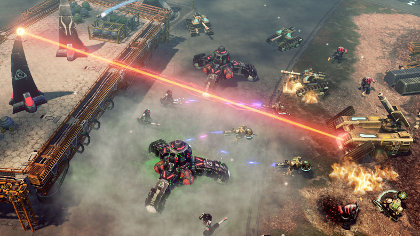
The dreaded Tower of NOD makes a comeback.
VGD: And obviously you don’t want to water it down for the core users.
Joshi: Yes, because we’ve made a lot of decisions to make it more accessible, but it’s not the Sims. It’s more accessible, but there’s definitely the hardcore contingent who are like “hey, we want to micromanage, we want to harvest Tiberium, we want to build a base and just hang out at the base”. Whereas we want to get people into the game, get the game moving a little bit faster. It’s a tough one.
I really think other genres are kind of splitting – though they aren’t really calling it out so much – and I think RTS should split too. You should have more of a casual vein, and more of a hardcore vein. There’s no way to satisfy both groups, and I think there’s interest from both sides.
VGD: Raj, thanks for your time.
Tiberian Twilight is out for PC on 16th March in North America and 19th March in Europe.
Quelle: http://videogamesdaily.com/interviews/201002/command-conquer-4-tiberian-twilight-interview/

